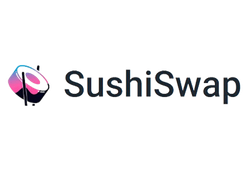
Stop overpaying - start transferring money with Ogvio. Join the waitlist & grab early Rewards NOW! 🎁
Don't want to deal with identity verification on a centralized exchange and want to contribute more to a platform's success? Then, SushiSwap can be a refreshing alternative, and this SushiSwap review is the right step to learn more about the platform.
With features like yield farming and governance participation, SushiSwap empowers users to shape the platform's future while potentially earning rewards.
However, note that the decentralized approach is inherently riskier than the centralized one using exchanges like Binance or Bybit because a lot of things are your responsibility, including security. If you decide to interact with cryptocurrencies on SushiSwap, I suggest that you use Ledger Nano X or Trezor Safe 5, hardware wallets that securely store your crypto offline.
Verdict at a glance: SushiSwap is a decentralized exchange (DEX) offering many features, including token swapping, liquidity provision, and yield farming. While it needs a deeper understanding of specific terms and has the risk of impermanent loss, the SushiSwap exchange rewards active participation with governance rights and potential returns. I think it's a good option for those comfortable with self-custody and seeking opportunities to earn rewards beyond simple trading.
Pros
- SUSHI governance token - available
- Staking and farming functionality
- A large number of tokens available
- Cross-chain swaps
- More opportunities to earn
Cons
- Controversial past
- Unfamiliar product terms
Table of Contents
- 1. What is SushiSwap?
- 2. SushiSwap Review: PROS
- 2.1. Reliable Security Measures
- 2.2. AMM-Powered Token Swapping
- 2.3. Swapping Tokens Across Chains
- 2.4. Potential to Get More Income
- 2.5. The SUSHI Token: Fueling Governance and Rewards
- 3. SushiSwap Review: CONS
- 3.1. Unfamiliar Product Terms
- 3.2. Impermanent Loss
- 4. How to Use SushiSwap?
- 4.1. How to Get Started?
- 4.2. How to Swap Tokens on SushiSwap?
- 4.3. How to Stake on SushiSwap?
- 5. Fees and Rewards
- 6. Conclusions
What is SushiSwap?
Let’s start this SushiSwap review by talking about the basics: what it is and how it generally works. SushiSwap is a decentralized cryptocurrency exchange (DEX), meaning it can facilitate peer-to-peer trading of cryptocurrencies without intermediaries.
Originally conceived by the anonymous Chef Nomi along with two other co-founders with the usernames 'sushiswap' and '0xMaki’, this platform was launched in 2020 as an innovative fork of Uniswap, another popular DEX. Aiming to disrupt the DeFi landscape, SushiSwap introduced the SUSHI token and offered enticing rewards to liquidity providers (I'll talk about it later!).

SushiSwap faced a major setback early on. Shortly after the platform’s launch, Chef Nomi unexpectedly cashed out a huge chunk of SUSHI tokens, causing a price crash. This shook the crypto world and raised concerns about decentralized governance. Despite this rocky start, SushiSwap persevered and has grown into a major player in DeFi.
Talking about the technical aspects, SushiSwap is built on the Ethereum blockchain, relying on smart contracts to ensure transparency and security in transactions[1].
Also, unlike centralized exchanges with order books, SushiSwap uses an automated market maker (AMM) model. This means trading pairs exist within liquidity pools, and prices are determined algorithmically based on the supply and demand within those pools.
SushiSwap Review: PROS
From the previous section, you know the basic information about this decentralized exchange. Now, let’s continue this SushiSwap review with what makes this DEX special!
Reliable Security Measures
SushiSwap DEX has prioritized user security by implementing several robust measures. One of the key safeguards is the use of multi-signature (multi-sig) wallets, requiring multiple authorized signatories to approve transactions.
To access the development fund on SushiSwap, a multi-signature approval from at least four out of six trusted members of the DeFi and Ethereum ecosystem is required.
Well, major decisions, such as fund allocation and big platform changes, are subject to community votes. However, this core team handles day-to-day operations and adjusts farming pairs based on market conditions, including this multi-sig approval.
This multi-signature system significantly enhances security by preventing unauthorized access. Requiring multiple approvals for transactions makes it harder for hackers to steal funds. It's like having multiple locks on a door instead of just one.
Another security measure on this platform that’s worth mentioning in this SushiSwap review is bug bounty programs. These programs incentivize white-hat hackers to identify vulnerabilities in the platform and report them responsibly, rather than exploiting them for malicious purposes.
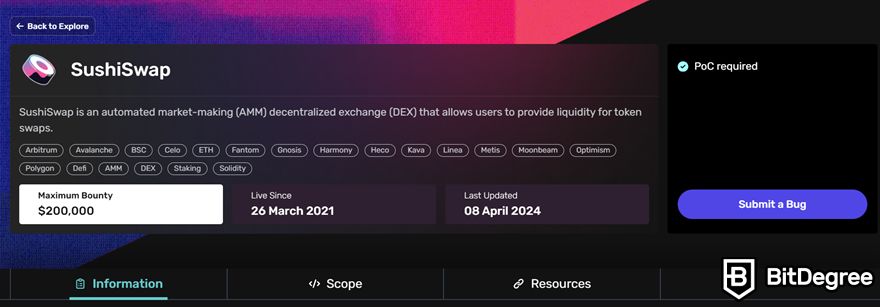
On SushiSwap, these white-hat hackers can get up to $200,000. For bug bounties up to $100,000, they receive payment in USDC. If the bounty is between $100,000 and $200,000, they get paid in SUSHI, but they can still choose to receive the first $100,000 in USDC if they prefer.
SushiSwap also has a security feature called FailSafe. This is a response to a major hack that occurred in 2023. The system is designed to intercept and block malicious transactions by acting like a “real-time guardian” for SushiSwap.
FailSafe continuously monitors SushiSwap for unusual or suspicious activity using advanced algorithms to identify potential threats. When a transaction is flagged as suspicious, this tool automatically intervenes to block it before it's executed. This proactive approach definitely improves the platform's security level.
Above all that, I think I also need to emphasize the role of security audit approval in this SushiSwap review. This platform's team conducts regular security checks and has a dedicated development fund, backed by 5% of its token supply. Although this scheme is new, it’s somewhat innovative and crucial for user safety.
AMM-Powered Token Swapping
Enough about the security. Now, let’s discuss the automated market marker on SushiSwap, one core aspect that I think might be discussed in any SushiSwap review.
For your information, AMM isn't only available on SushiSwap. It's a technology adopted by other decentralized exchanges, such as Uniswap and PancakeSwap. These platforms use AMM to facilitate token trading by using liquidity pools, so there's no need for a centralized order book matching buyers and sellers. Instead, trades are executed directly from the liquidity pool, providing a more efficient and decentralized trading experience.
AMM helps SushiSwap have robust functionality beyond simple token swapping on this DEX. SushiSwap, with this technology, can support token swapping, price determination, and yield farming.
Now, let’s talk about how AMM supports SushiSwap’s core function: swapping tokens.
The AMM protocol on SushiSwap operates by creating liquidity pools filled with equal-value amounts of two tokens. To swap tokens, you simply choose the tokens you want to exchange, input the amount, and confirm the transaction. The protocol automatically calculates the best exchange rate based on the liquidity in the pool and adjusts the pool's balance to maintain a constant product.
Moreover, SushiSwap supports many cryptocurrencies, including well-known gaming coins like SAND and AXS, as well as a variety of altcoins and stablecoins, such as USDC and DAI. While the number of tokens and coins available in this DEX is not entirely clear, it supports over 11,000 swapping pairs.
Swapping Tokens Across Chains
The variety of supported cryptocurrencies expands as this platform now enables cross-chain swaps. Unlike many other DEXs that rely on intermediaries or complex bridging processes, cross-chain swapping on SushiSwap (it’s called SushiXSwap, by the way) enables users to seamlessly transfer assets between different blockchains.
First introduced in September 2022, SushiXSwap claimed to be the first-ever cross-chain swap aggregator in any DEX. SushiSwap then recently announced its second version, called SushiXSwap v2, with expanded network support, a wider range of swappable tokens, and improved user experience and security.
At the time of writing, users can seamlessly swap assets across 15 supported chains without the need for wrapping or bridging. These chains include Arbitrum, Optimism, and Polygon. This interoperability breaks down silos and provides users with greater flexibility.
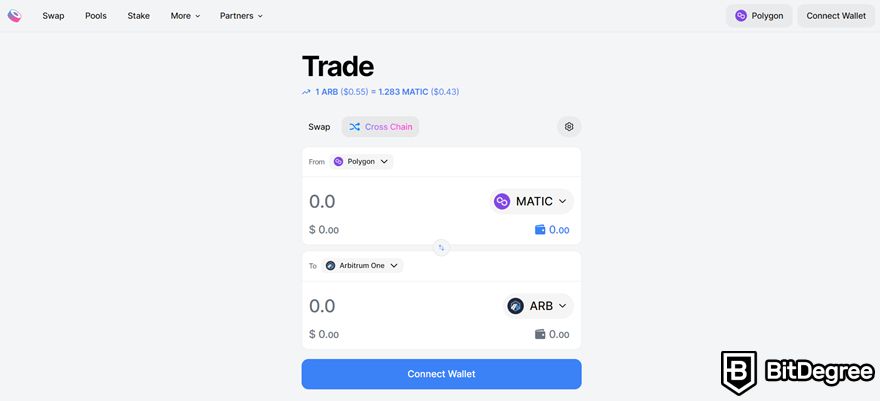
In this second version, SushiSwap users benefit from the integration of USDC, backed by Circle, through the Cross-Chain Transfer Protocol (CCTP). So, instead of different versions of USDC for each blockchain, CCTP allows for a unified USDC token that can be minted and burned across supported chains without fees.
This improves liquidity, stabilizes value across networks, and simplifies cross-chain swaps for SushiSwap DEX users, as they can interact with a single USDC token regardless of the blockchain they're on.
Another tool that I want to highlight in this SushiSwap review is Payload Executors. It streamlines cross-chain swaps by allowing users to pay transaction fees on the source chain instead of the destination chain.
This innovation simplifies the process and removes the need for additional gas tokens on the receiving chain. No need to worry anymore if you don’t have enough tokens for the gas fees on the destination chain.
Potential to Get More Income
SushiSwap offers more than just swapping. Unlike Uniswap, which focuses primarily on token exchanges, it enables users to stake their SUSHI tokens to earn rewards.

Staking essentially involves locking up your SUSHI tokens for a period to support the SushiSwap ecosystem. While your SUSHI is staked, you can’t trade or transfer it. The locked-up duration varies depending on the specific staking program, but it's typically a matter of hours or days.
By staking SUSHI, you receive xSUSHI in return, which grants you voting rights and a share of platform fees. What is xSUSHI exactly? I’ll elaborate on it in the next section of this SushiSwap review, but shortly, xSUSHI is a tokenized version of SUSHI that represents your staked assets.
Yield farming is another popular way to earn on SushiSwap. By providing liquidity to trading pairs, you earn a share of the trading fees generated by the pool.
This functionality is optimized by the integration of BentoBox, a permissionless and non-custodial smart contract wallet. BentoBox improves the yield farming experience by removing gas fees for deposits and withdrawals, as well as offering additional features like flash loans. That way, users can maximize their earnings while enjoying a smoother and more cost-effective process.

Depositing tokens into BentoBox also enables you to earn shares representing your portion of the total funds. As BentoBox grows through flash loan fees and other profitable activities, your share also increases, meaning you can potentially earn returns simply by storing your tokens in BentoBox.
SushiSwap also rewards liquidity providers through additional incentives. These incentives often come from other DeFi projects looking to boost their liquidity. When you stake your tokens in a farm that offers two types of rewards, one reward (usually SUSHI) is provided by SushiSwap, while the other token is contributed by the partnering project. These dual-reward farms are known as Onsen farms.
The SUSHI Token: Fueling Governance and Rewards
We’ve talked a bit about the SUSHI token in the previous sections, now, let’s dive deeper into it in this part of the SushiSwap review.
Built on Ethereum, the SUSHI token adheres to the ERC-20 standard. This ensures compatibility with a vast ecosystem of Ethereum-based wallets, exchanges, and decentralized applications.
This token is the cornerstone of the SushiSwap exchange ecosystem as it serves multiple critical functions. Obviously, it’s a medium of exchange within the platform, allowing users to trade it for other digital assets.
More importantly, SUSHI serves as a governance token when staked (and then you get xSUSHI, in return, that acts as the “real governance token”). A governance token means that this asset offers holders similar rights to shareholders in publicly traded firms[2].
xSUSHI holders have a say in the platform's direction, from deciding on new features to allocating treasury funds and taking part in the fee distribution that comes from the protocol. This democratic process allows the community to vote on crucial decisions such as protocol upgrades, fee structures, and treasury management.
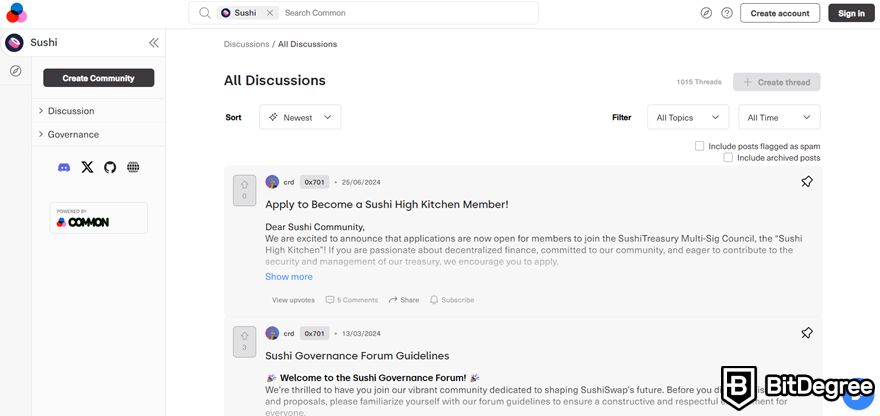
A key takeaway from this part of my SushiSwap review is that only xSUSHI holders have governance rights. SUSHI holders don’t directly participate in governance. This function is the reason xSUSHI has a higher value than SUSHI.
To earn voting power on SushiSwap, you first need to convert your SUSHI to xSUSHI through the SushiBar. Only then do you gain voting power in the platform's governance, named SushiPowah. Note that the amount of xSUSHI you hold determines your influence in governance proposals, with a minimum of 5 million SushiPowah required for a proposal to pass.
I know these whole terms may be confusing (which I think is the main drawback of SushiSwap, but we’ll talk about it later). So, here’s to summarize the process:
Step 1: You stake your SUSHI in the SushiBar to receive xSUSHI.
Step 2: The amount of xSUSHI you hold determines your SushiPowah.
Step 3: SushiPowah grants you voting rights within the SushiSwap governance system.
Although the process seems complicated, it's there to make the workflow structured and transparent.
Well, besides participating in governance decisions, xSUSHI holders can reap financial rewards from the platform’s trading fees as they’re entitled to a share of these fees.

Did you know?
All Crypto Exchanges may look similar to you but they're NOT all the same!
SushiSwap Review: CONS
From this point of the SushiSwap review, I think you’ve noticed a bunch of useful features and technology in the DEX. SushiSwap, while offering those advantages, also comes with several aspects you should take into consideration before using it.
Unfamiliar Product Terms
In the preceding sections, we explored various terms associated with SushiSwap. A unique aspect of the platform's branding is its use of catchy exchange-specific phrases related to 'the original sushi,' just like the renowned Japanese dish.
Well, this can be both an advantage and a disadvantage. On one hand, it helps create a distinct identity for the platform. However, terms like 'MasterChef', which represents SushiSwap's yield farming program and 'BentoBox', which provides a platform for building DeFi apps, can also create a learning curve for new users. This barrier to entry might deter potential users who are unfamiliar with the jargon.
However, don’t worry. SushiSwap puts a right diagonal symbol on a term that might be unfamiliar to users as a way to give information. Clicking on these icons reveals additional details or explanations.
Impermanent Loss
Impermanent loss is a potential risk for those who provide liquidity to a decentralized exchange overall, including SushiSwap. It occurs when the price of the assets in a liquidity pool changes drastically compared to when you deposited them[3].

Imagine you deposit equal amounts of two tokens, Token A and Token B, into a liquidity pool. If the price of Token A doubles while the price of Token B remains stable, the protocol will automatically rebalance the pool to maintain a 50/50 ratio. This means you'll end up with less of Token A and more of Token B than if you had simply held onto your original tokens.
The loss is considered "impermanent" because if the token prices return to their original ratio when you withdraw your liquidity, you won't incur a net loss. However, if the price divergence persists, the loss becomes permanent.
It's important to weigh the potential rewards of liquidity provision (trading fees, governance tokens) against the risk of impermanent loss when making your investment decisions.
How to Use SushiSwap?
After weighing the pros and cons outlined in the previous sections of my SushiSwap review, are you ready to explore the platform further? I hope you are because we'll dive into the steps to get started and discover features like swapping and staking.
How to Get Started?
To get started on any decentralized exchange, you just need to connect your wallet instead of creating a new account and password or performing the know-your-customer (KYC) verification like you do on centralized exchanges.
Follow the steps below to connect your wallet to SushiSwap (In this case, I use Coinbase Wallet for illustration):
Step 1: Go to its official website and select the network you want to use.
Step 2: Click the “Connect Wallet” button in the upper right corner or below the converter and pick your preferred and available wallet, as there are several options.
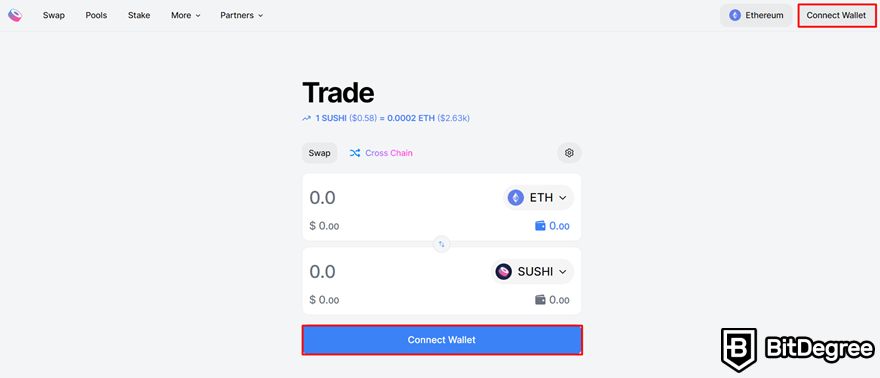
Step 3: Follow the on-screen instructions, as different wallets may require specific steps. If you use Coinbase Wallet, you need to create a "Smart Wallet by Coinbase Wallet" account. Alternatively, use any existing passkey or scan a code with your Coinbase Wallet mobile app if you already have one.
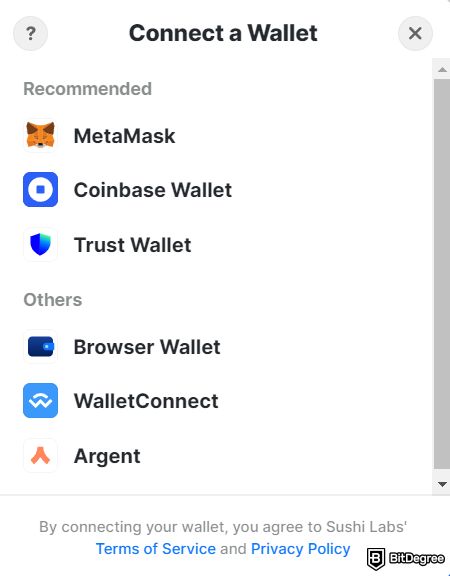
Once connected, you can see your balance and other details, such as your purchasing activity and specific features according to which wallet you use.
As you can see, SushiSwap and Coinbase Wallet support a variety of networks, but the available tokens depend on the chosen network. Therefore, it's important to check the specific requirements for the network you want to use. If you're using the Ethereum network, for example, ensure you have enough ETH to cover gas fees for your transactions.
Generally, the wallet and swapping options sync automatically whenever you change the network on the SushiSwap exchange.
I personally use Ledger Nano X to store my assets because this device offers unparalleled security. If you’re like me, connect your Ledger to Coinbase Wallet before syncing the wallet with the SushiSwap DEX and using the features.
How to Swap Tokens on SushiSwap?
Once you’re all set with the wallet connection, follow the steps below to start swapping tokens:
Step 1: On the "Swap" page, choose which token you want to swap by clicking on the token icon in the topmost box. You can scroll down or type the token name on the search bar.
![]()
Step 2: Enter the amount of token you want to swap and click on the "Swap" button to continue.
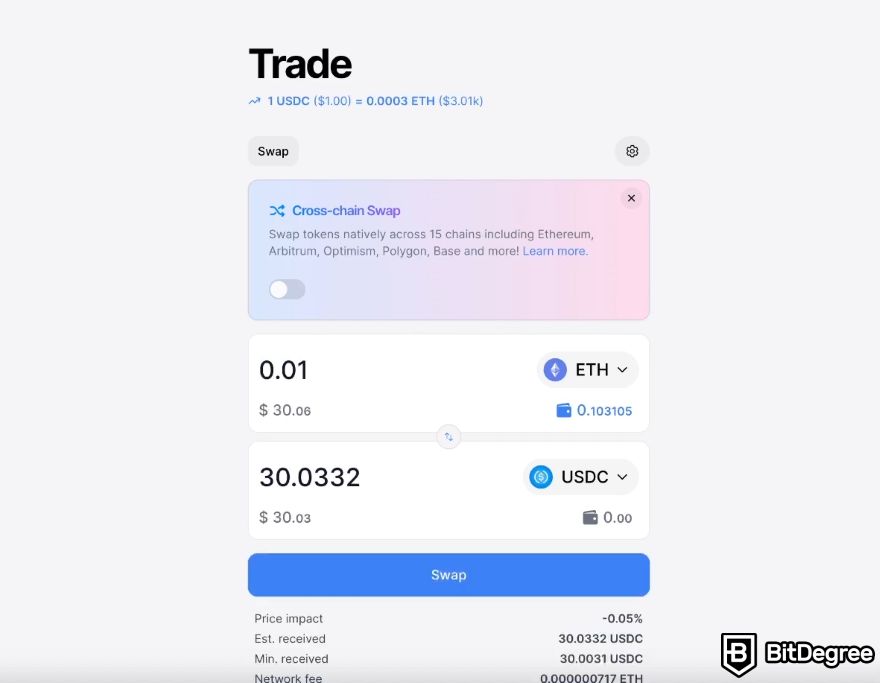
Step 3: Hit the “Confirm” button in your wallet. If you use an additional wallet, that wallet’s prompt pops up as well.
You should see a “Success” pop-up message after the transaction is complete and the number of assets you swapped under the asset icon on the lowest box. The number usually is also automatically listed on your wallet.
The process is quite simple when you swap tokens within the same network. Things get a little bit more complicated if you want to use the cross-chain transfer swap feature. An example is when you want to convert AVAX tokens from the Avalanche network to MATIC tokens on the Polygon blockchain.
Here’s how you can transfer assets from one network to another on SushiSwap:
Step 1: Activate the cross-chain swap feature by clicking the toggle-switch button. After that, you should see a slightly different interface on the box as this feature shows from which network the token is on the “From” and “To” boxes.
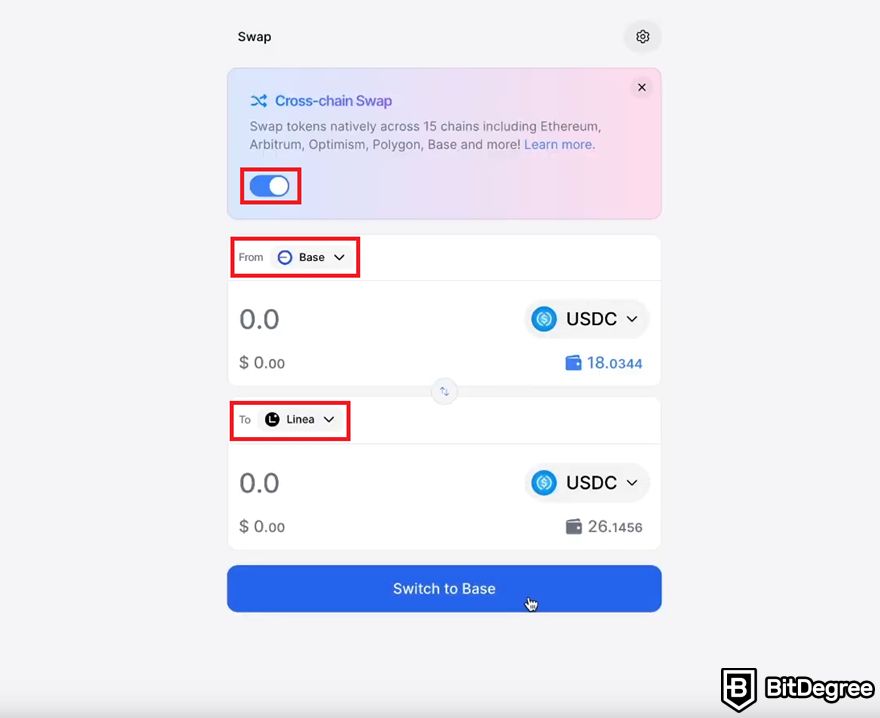
Step 2: Select the network you swap from and the specific token, and do the same for the token you want to swap to.
Step 3: Type the number of tokens you want to transfer and swap. To see how many tokens you have, SushiSwap shows the available balance below the token icon on each box.
Step 4: Double-check the details. Once you’re sure, click the “Switch” button and then hit the “Approve” button.
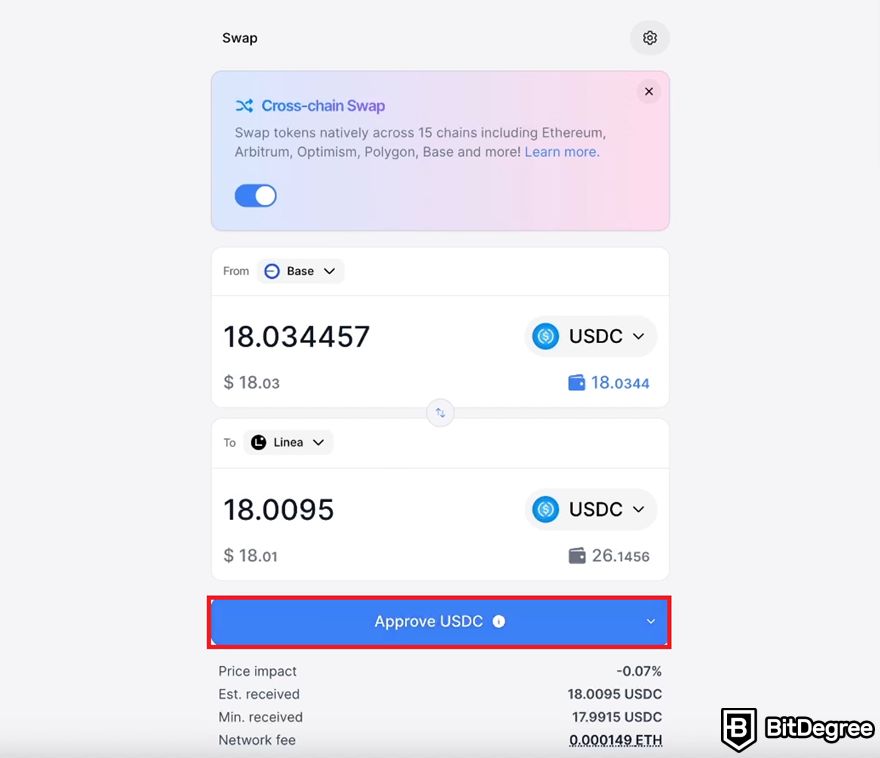
Step 5: Approve the transaction on your wallet and hit the “Approve” button once again.
Once everything is complete, wait for the cross-chain swap to process. In this step, you may see the tokens on your wallet move over. You may have to confirm the transactions multiple times if you use a hardware wallet connected to your transaction wallet.
How to Stake on SushiSwap?
To stake on SushiSwap DEX, make sure you have the SUSHI token in your wallet. If not, you need to swap first by following the steps in the previous section.
Staking on SushiSwap is relatively easy with these four steps:
Step 1: Click “Stake” on the top menu bar.

Step 2: Enter the number of SUSHI you want to stake. If you want to go all in, just click the balance below the SUSHI icon on the “Stake” box.

Step 3: Hit the “Approve SUSHI” button and confirm the transaction on your wallet.
Step 4: Click the “Stake” button and confirm it again on your wallet.
Once you finish, you should see your xSUSHI balance under the Balance box.
Fees and Rewards
I've covered the essential aspects of this DEX in my SushiSwap review, from its helpful core features to its downsides. To make an informed decision about using the platform, understanding fee structures is crucial. So, let’s explore the costs (and rewards) associated with using SushiSwap!
SushiSwap charges a 0.3% fee on each trade. Of this amount, 0.25% is distributed as a reward to liquidity providers who hold xSUSHI, incentivizing their contributions to the platform's liquidity.
The remaining 0.05% is allocated to the SushiSwap treasury to fund development and buy back SUSHI tokens. These repurchased SUSHI tokens are then distributed to xSUSHI holders, creating a continuous reward system for the community.
Rewards given to liquidity providers are pre-determined and given in equal amounts daily.

The number of rewards a liquidity provider earns is directly tied to their share of the liquidity pool. For instance, if you own 3% of the total liquidity in a pool, you receive 3% of the generated fees. However, this percentage can fluctuate as other users add or remove liquidity from the pool.
Essentially, the more liquidity you provide, the higher your potential earnings.
In the earlier part of this SushiSwap review, I talked about how the values of SUSHI and xSUSHI are different, but these are interconnected because the SushiBar exchange rate between SUSHI and xSUSHI fluctuates based on the platform's performance.
For instance, SUSHI is valued at $1.03. It might equate to approximately 0.7376 xSUSHI, which is also worth $1.03, with a potential to increase because xSUSHI gains value from the platform's trading fees. Over time, the ratio of SUSHI to xSUSHI will shift as the platform's revenue grows.

- Secure and reliable
- Accepts fiat currencies
- Lots of trading options
- Reputable exchange
- Accepts fiat currencies
- Offers various trading options

- Huge trading variety
- Regulation-compliant around the globe
- Fair trading fees
- Beginner-friendly
- A wide array of features
- Vast number of different crypto coins & tokens

- Beginner-friendly
- Secure
- Decent trading and withdrawal fees
- Crypto.com Visa Card
- Automated tools & bots
- Ecosystem synergy with CRO
Conclusions
After reading this SushiSwap review, you might have noticed that this platform is one of the key players among other decentralized exchanges. It offers robust functionality for trading, yield farming, and governance.
By combining decentralized finance principles with innovative features like cross-chain swaps and the SUSHI token used within the DEX, SushiSwap has attracted a large and active community.
While challenges like impermanent loss and complex terminology exist, the platform's potential for growth and its role in shaping the future of DeFi is undeniable, and it’s your choice to decide whether SushiSwap is the right option for you.
If you prefer a more centralized approach, consider platforms like Binance, Bybit, and Kraken which operate within a regulated framework, providing more perks for users than the decentralized SushiSwap.
The content published on this website is not aimed to give any kind of financial, investment, trading, or any other form of advice. BitDegree.org does not endorse or suggest you to buy, sell or hold any kind of cryptocurrency. Before making financial investment decisions, do consult your financial advisor.
Scientific References
1. A. Šilenskytė, J. Butkevičienė, A. Bartminas: ‘Blockchain-Based Connectivity Within Digital Platforms and Ecosystems in International Business’;
2. C. A. Makridis, M. Fröwis, K. Sridhar, et al.: 'The Rise of Decentralized Cryptocurrency Exchanges: Evaluating the Role of Airdrops and Governance Tokens';
3. K. Shah, D. Lathiya, N. Lukhi, et al.: ’A Systematic Review of Decentralized Finance Protocols’.


